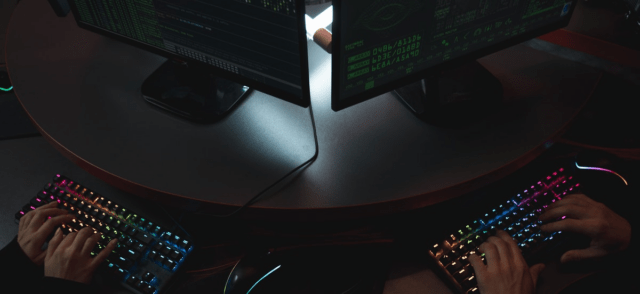Multi-Factor Authentication (MFA): what you need to know
Read our blog to find out what Multi-Factor Authentication (MFA) is, why it’s vital to have it and how AI makes it more secure & efficient.
Read our blog to find out what Multi-Factor Authentication (MFA) is, why it’s vital to have it and how AI makes it more secure & efficient.

In our interconnected digital world, where sensitive information is transmitted and stored with a click or a tap, safeguarding our online accounts has become an absolute necessity. One of the most effective tools in the fight against cyber threats is Multi-Factor Authentication (MFA).
As cyberattacks continue to evolve in sophistication, traditional username-password combinations are proving to be insufficient in providing robust protection. MFA, however, offers an additional layer of security that can significantly fortify your online presence.
So let’s take a look at:
A core component of a strong identity and access management policy, multi-factor authentication is a security measure that requires users to provide two or more verification factors to gain access to a resource, such as an application, online account, or a Virtual Private Network (VPN).
Rather than just asking for a username and password, MFA requires other, additional, credentials. This adds an extra layer of protection to systems, making it significantly harder for unauthorized individuals to breach cyber defenses.
MFA operates on the principle of securing your data through multiple validations. These validations are categorized into the following three stages.
During this stage, the user registers their account with the system, providing the necessary details and choosing their preferred authentication factors. This could be a password, a biometric factor, or a physical token.
When the user attempts to access the system, they are prompted to provide the authentication factors with which they registered. This could involve entering a password, scanning a fingerprint, or providing a token.
If the user successfully provides the correct authentication factors, they are granted access to the system. If not, access is denied.
When we talk about multi-factor authentication, we refer to the use of multiple factors or elements to verify a user’s identity. These factors are typically categorized into five distinct types: knowledge, possession, inherence, location, and time.
Each factor in multi-factor authentication represents a different category of data that can be used to authenticate a user’s identity. Listed below are the five commonly recognized factors used, and how they work in the context of MFA.
There are numerous other types of MFA, each with its own unique approach to verifying a user’s identity. These different types offer a range of security levels and user experiences, allowing organizations to choose the solution that best fits their needs.
They include:
TOTP are passwords that are valid for only one login session or transaction and expire after a certain period.
Fast Identity Online (FIDO) is an open standard for passwordless authentication. Universal 2nd Factor (U2F) is a hardware-based authentication method that requires the user to present a physical device.
These methods send an authentication code to the user’s registered email or phone number, which they must enter to gain access.
This biometric method requires the user to scan their fingerprint to gain access.
This method uses a physical device (token) that the user possesses to authenticate their identity.
These are questions that only the user should know the answer to. They are typically used as a secondary authentication method.
This method assesses the risk associated with a user’s login attempt based on factors such as their location, device, and behavior, and adjusts the authentication requirements accordingly.
With the proliferation of online services and the increasing value of digital data, the stakes have never been higher. While traditional password-based security measures have served us well in the past, they are no longer sufficient in the face of modern challenges.
Passwords are often the only thing that stands between an attacker and a user’s account. However, passwords can be easily guessed through brute force attacks or cracked, especially if they are weak or reused across multiple accounts.
MFA adds an additional layer of security by requiring users to provide something they know (their password) and something they have (a physical token or their phone) in order to authenticate.
Attackers are constantly developing new techniques to breach systems and steal data. MFA can help to protect against these attacks by making it more difficult for attackers to gain access to accounts, even if they have compromised a user’s password.
Many industries, such as financial services and healthcare, have compliance requirements that mandate the use of MFA. By implementing multi-factor authentication, organizations can help to ensure that they are meeting these requirements.
Multi-Factor Authentication (MFA) offers a range of benefits that significantly enhance online security and protect users from a variety of cyber threats. Here are some key advantages of using MFA:
By requiring users to provide multiple authentication factors, MFA makes it harder for attackers to gain access to systems, thereby reducing security risks.
Multi-factor authentication can enable digital initiatives by providing a secure way for users to access online services and applications.
With MFA, you can detect and respond to security incidents more quickly, as you can identify unauthorized access attempts more easily.
By enhancing the security of your online services, multi-factor authentication can help to increase conversion rates.
Users are more likely to trust and use your services if they know that their data is protected by MFA.
By preventing security breaches, MFA can help to reduce the operational costs associated with responding to such incidents.
As mentioned earlier, many industries require the use of MFA for compliance. Implementing multi-factor authentication can help you to meet these requirements.
With MFA, users can securely access systems from any location, which can increase flexibility and productivity.
While MFA offers many benefits, it also comes with its own set of challenges.
Security policy fatigue refers to the feeling of frustration and disengagement people experience due to the overwhelming complexity and abundance of security measures they must follow. This can lead to individuals ignoring or bypassing security practices, potentially compromising digital security.
To address this, organizations should provide clear and user-friendly security policies and education to prevent users from becoming indifferent to security measures.
MFA bombing is when a threat actor triggers several, repeated MFA push requests to a victim’s enrolled smart device. They do this in the hope that the user will eventually tire of pressing ‘reject’ and make the issue go away by clicking ‘accept’ – unwittingly allowing the threat actor to gain access to their digital identity and organization’s protected data.
MFA can be costly for organizations, both in terms of the hardware and software required to implement it, as well as the cost of training users on how to use it.
Multi-factor authentication can be complex to implement and manage, especially for organizations with a large number of users or systems. This can lead to errors and vulnerabilities.
Despite these challenges, there are ways to make MFA more user-friendly and cost-effective:
Organizations should make multi-factor authentication as easy to use as possible. This includes using simple and intuitive authentication methods, such as push notifications or hardware tokens.
However, it’s important to remember that push notifications could cause security fatigue and/or MFA bombing as explained above which means that access could be granted to malicious actors from just accepting them.
Cloud-based MFA solutions can help organizations reduce the cost and complexity of implementing and managing multi-factor authentication. These solutions are also typically easier to use.
Don’t try to implement multi-factor authentication for all of your users and systems at once. Start with a small number of users and systems and gradually expand from there.
To get the most out of multi-factor authentication, consider the following best practices.
Choose authentication factors that are appropriate for your organization and users. For example, if your users are often on the move, consider using mobile-based factors such as SMS or push notifications.
Create user roles and assign appropriate access rights to each role. This can help to reduce the risk of unauthorized access.
Ensure that your users have strong passwords. This can be enforced through password policies that require the use of a mix of characters, numbers, and special characters.
Before rolling out MFA to your entire organization, test it with a small group of users to identify and fix any issues.
Monitor the usage of multi-factor authentication in your organization to identify any issues or trends.
Regularly rotate security credentials to reduce the risk of them being compromised.
Follow the principle of least privilege, which means giving users only the access they need to perform their job. This can help to reduce the risk of unauthorized access.
AI can greatly enhance the effectiveness of MFA in several ways.
AI can be used to make multi-factor authentication more adaptive to the user’s environment. For example, if the user is connecting from a trusted device or location, AI can reduce the number of factors required for authentication.
AI can be used to detect fraudulent activity, such as when an attacker is trying to use stolen credentials to access a system or application. AI can do this by analyzing the user’s behavior and looking for patterns that are indicative of fraud.
AI can be used to provide personalized security advice to users. This advice can be based on the user’s risk profile and the latest security threats.
AI can be used to simplify the user experience of multi-factor authentication. This can be done by making the authentication process more intuitive and user-friendly.
Several companies are already leveraging AI to enhance their multi-factor authentication solutions.
Google’s Advanced Protection Program uses AI to make MFA more secure for users. The program uses a combination of factors, including physical security keys, risk analysis, and machine learning to protect users from phishing attacks and other forms of fraud.
Microsoft Azure Active Directory works by making multi-factor authentication more adaptive to the user’s environment. The program uses factors, such as the user’s location and the device they are using, to determine the number of steps required for authentication.
Cisco’s Duo Security uses AI to detect fraudulent activity. The program analyzes the user’s behavior and looks for patterns that are indicative of fraud. If the program detects fraudulent activity, it will block the user’s access to the system or application.
The frequency of extra authentication depends on the MFA method and the policies set by an organization. Some methods require extra authentication every time you log in, while others may only require it when logging in from a new device or location.
Two-factor authentication (2FA) is a subset of multi-factor authentication. 2FA requires two authentication factors, while MFA can require two or more.
Adaptive authentication is a method of MFA that adjusts the authentication requirements based on the user’s environment. For example, if the user is connecting from a trusted device or location, the system may require fewer authentication factors.
MFA is a method of verifying a user’s identity requiring multiple authentication factors. Single Sign-On (SSO) is a method of access control that allows a user to log in once and gain access to multiple systems without needing to log in again.
MFA can be more complex to use than single-factor authentication, as it requires users to provide multiple authentication factors. However, many MFA methods are designed to be user-friendly and easy to use.
MFA should be used for any system or application that contains sensitive data. This includes email accounts, online banking, cloud storage, and any other services that hold personal or business information.
Multi-factor authentication is a key component of any robust cybersecurity strategy, providing an additional layer that can protect your systems and data from unauthorized access. While implementing MFA can come with its own set of challenges, these are far outweighed by the benefits it offers.
If you have implemented MFA within your organization, you may want to consider using our password strength testing service to help you identify vulnerabilities in one of the most vulnerable aspects of multi-factor authentication.
Partner with our expert Swarm of ethical hackers to ensure your cybersecurity stance keeps pace with the bad actors. Contact us for more information about multi-factor authentication.

MFA Bombing
Why might your smartphone be pinging you in the middle of the night?

Security fatigue
It’s not ‘new news’ that there have been numerous cybersecurity incidents across various industries over the last months, and whilst each of the impacted businesses would…

What are brute force attacks?
Read our blog to find out what brute force attacks are, how they work, why they’re dangerous and how to identify, recover from and prevent them.